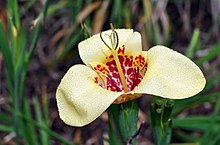Species of plant in the family Iridaceae
Tigridia pavonia
A yellow-flowered form
Scientific classification
Kingdom:
Plantae
Clade :
Tracheophytes
Clade :
Angiosperms
Clade :
Monocots
Order:
Asparagales
Family:
Iridaceae
Genus:
Tigridia
Species:
T. pavonia
Binomial name
Tigridia pavonia
Synonyms [ 2]
Beatonia grandiflora (Cav.) KlattBeatonia lutea (Link, Klotzsch & Otto) KlattFerraria pavonia L.f.Ferraria tigridia Sims nom. illeg.Marica tigridia (Sims) Lehm. nom. illeg.Moraea grandiflora (Cav.) Pers.Moraea pavonia (L.f.) Thunb.Moraea tigridia (Sims) BakerSisyrinchium grandiflorum Cav.Sisyrinchium palmifolium Sessé & Moc. nom. illeg.Tigridia conchiflora SweetTigridia grandiflora (Cav.) Diels nom. illeg.Tigridia grandiflora Salisb. nom. illeg.Tigridia lutea Link, Klotzsch & OttoTigridia oxypetala R.MorrisTigridia pringlei S.WatsonTigridia speciosa Poit.Vieusseuxia pavonia (L.f.) DC.
Tigridia pavonia species of flowering plant in the iris family Iridaceae . Common names include jockey's cap lily ,[ 3] Mexican shellflower ,[ 4] peacock flower ,[ 4] tiger iris ,[ 5] tiger flower .[ 4] bulbous herbaceous perennial is widespread across much of Mexico , Guatemala , El Salvador , and Honduras . It is naturalized in Ecuador and Peru .[ 4] [ 6]
The leaves are narrow and lance-shaped. The three-petalled blooms occur in a variety of colours with strongly contrasting central markings.[ 7] [citation needed
Tigridia pavonia is cultivated as an ornamental plant . It prefers a sheltered position in full sun, in sandy but fertile soil. The plants are said to be hardy to as low as −12 °C (10 °F) in many sources,[ 8] [ 9] [ 10] [ 7] [ 7] [ 10]
The roasted bulbs are edible and have been used by the American Indians and Indigenous peoples of Mexico . It has a chestnut -like flavour.[ 5]
The aphid Aphis newtoni [ 11]
References
^ "Tigridia pavonia " . International Plant Names Index (IPNI)Royal Botanic Gardens, Kew ; Harvard University Herbaria & Libraries ; Australian National Botanic Gardens . Retrieved 2 August 2021 .^ "Tigridia pavonia " . World Checklist of Selected Plant Families Royal Botanic Gardens, Kew – via The Plant List .World Flora Online ^ Books, M.; Limited, M.B.P. (2004). Growing Bulbs ISBN 9781740455206 ^ a b c d "Tigridia pavonia " . Germplasm Resources Information Network Agricultural Research Service , United States Department of Agriculture . Retrieved 16 January 2014 .^ a b Alan Davidson The Oxford Companion to Food Google Books
^ Kew World Checklist of Selected Plant Families ^ a b c "Tigridia pavonia " . RHS. Retrieved 28 July 2021 .^ Taylor's Encyclopedia of Garden Plants. Frances Tenenbaum, ed. Houghton Mifflin, 2003. p. 387. ISBN 9780618226443 ^ "Tigridia pavonia" . Plants for a Future . Retrieved 25 March 2024 .^ a b "Tigridia pavonia" at North Carolina Extension Gardener Plant Toolbox. Retrieved 25 March 2024.^ Proceedings of the Estonian Academy of Sciences, Biology and Ecology June 2002 Proceedings of the Estonian Academy of Sciences, Biology and Ecology June 2002 Google Books
Tigridia pavonia Ferraria pavonia




